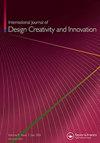从个体层面探讨文化与创造体验的关系——基于两个设计任务的个案研究
IF 2.5
Q4 ENGINEERING, MANUFACTURING
International Journal of Design Creativity and Innovation
Pub Date : 2023-01-06
DOI:10.1080/21650349.2022.2157889
引用次数: 2
摘要
广泛的研究集中在文化和创造力之间的关系上。然而,相关研究通常采用国家文化价值观,将国家作为自变量来探索文化与个人创造力之间的关系,或者得出不一致的结论。因此,本研究试图从现象学的角度,以中国某大学27名学生完成的两项设计任务为基础,在设计过程中的个体层面上探索这种关系。研究结果显示,在6-3-5和合作素描(C-ketch)这两种创作方法中,快乐与个人文化价值观的长期和短期取向之间存在正相关,这两种方法具有统计学意义。然而,启蒙与长期与短期取向之间的相关性仅存在于6-3-5方法中。基于分析,我们发现个体的教育水平影响了他们在创造力体验中的自我评价,并且6-3-5方法对参与者来说比C-ketch方法更有利。此外,我们基于创造力的成分理论和霍夫斯泰德的文化理论,建立了一个可视化框架,解释了文化与创造力之间的关系。此外,这项研究可能为进一步研究个人文化与创造力体验之间的关系奠定基础。本文章由计算机程序翻译,如有差异,请以英文原文为准。
Exploration of the Relationship Between Culture and Experience of Creativity at the Individual Level: A Case Study Based on Two Design Tasks
ABSTRACT Extensive research has focused on the relationship between culture and creativity. However, related studies typically adopt national cultural values, set countries as independent variables to explore the relationship between culture and individuals’ creativity, or have inconsistent conclusions. Therefore, this study attempted to explore this relationship at the individual level in design processes from a phenomenological perspective, based on two design tasks carried out by 27 students at a university in China. The results showed a positive association between pleasure and long-term versus short-term orientation of individual cultural values in the two creative methods – 6-3-5 and collaborative sketching (C-sketch) – which were statistically significant. However, the correlation between enlightenment and long-term versus short-term orientation only existed in the 6-3-5 method. Based on the analysis, we found that an individual’s educational level affected their self-evaluation in the experience of creativity, and the 6-3-5 method was more favorable than the C-sketch method for the participants. Moreover, we developed a visualization framework and explained the relationship between culture and creativity based on the componential theory of creativity and Hofstede’s culture theory. Furthermore, the study might serve as a groundwork for further examination of the relationship between individuals’ culture and their experience of creativity.
求助全文
通过发布文献求助,成功后即可免费获取论文全文。
去求助
来源期刊

International Journal of Design Creativity and Innovation
ENGINEERING, MANUFACTURING-
CiteScore
3.80
自引率
27.80%
发文量
15
期刊介绍:
The International Journal of Design Creativity and Innovation is an international publication that provides a forum for discussing the nature and potential of creativity and innovation in design from both theoretical and practical perspectives. Design creativity and innovation is truly an interdisciplinary academic research field that will interest and stimulate researchers of engineering design, industrial design, architecture, art, and similar areas. The journal aims to not only promote existing research disciplines but also pioneer a new one that lies in the intermediate area between the domains of systems engineering, information technology, computer science, social science, artificial intelligence, cognitive science, psychology, philosophy, linguistics, and related fields. The journal covers, but is not restricted to, the following topics: ·Theories on Design Creativity and Innovation ·Cognition of Design Creativity ·Innovative Process ·Inventive Process ·Analogical Reasoning for Design Creativity and Innovation ·Design Synthesis ·Method and Tools for Design Creativity and Innovation ·Representation of Design Creativity and Innovation ·Education for Design Creativity and Innovation ·Concept Generation and Inspiration.
 求助内容:
求助内容: 应助结果提醒方式:
应助结果提醒方式:


